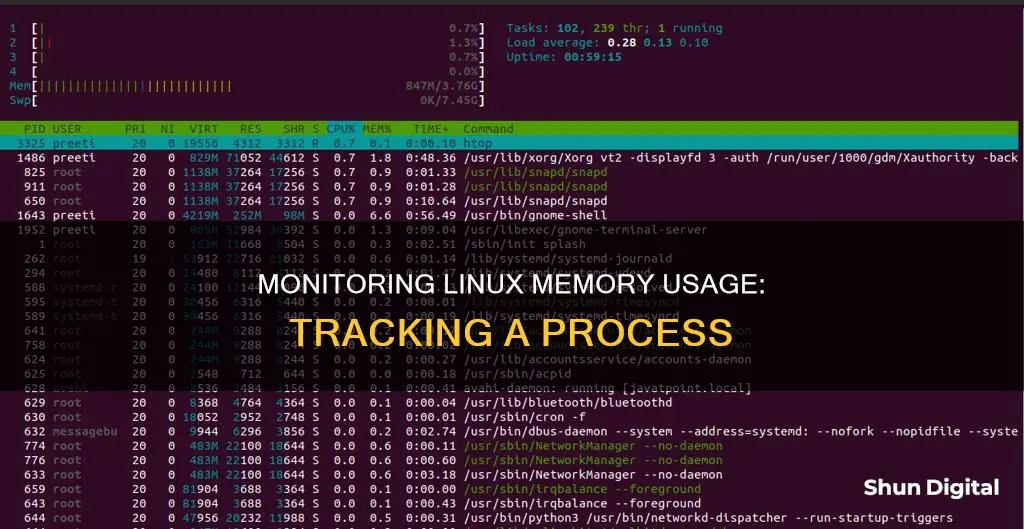
There are several ways to monitor the memory usage of a process in Linux. Here are some of the most common methods:
- Using the `ps` command: This command provides detailed information about running processes, including memory usage. You can use the `-e` option to show all processes, regardless of the user, and the `-o` option to specify the output format, such as memory usage.
- Using the `top` command: This command provides a dynamic, real-time view of processes and their memory usage. You can use the `-U` option to display processes for a specific user, and press `Shift + M` to sort processes by memory usage.
- Using the `pmap` command: This command reports the memory map of a process, including the size, permissions, and mapping location. It provides detailed information about each memory mapping, such as size, resident set size (RSS), shared, and private memory usage.
- Using the `/proc/[PID]/` directory: This directory provides detailed information about a specific process, including memory usage. You can obtain memory usage information from files such as `/proc/[PID]/statm` and `/proc/[PID]/status`.
- Using GUI tools: Graphical interfaces like GNOME System Monitor, KDE System Monitor, and Xfce Task Manager provide a user-friendly way to monitor memory usage.
- Using third-party tools: Tools like Nagios, Zabbix, and Cacti offer advanced memory monitoring capabilities, including alerting, trend analysis, and historical data.
| Characteristics | Values |
|---|---|
| Command-line tools | ps, top, htop, pmap, smem |
| GUI tools | GNOME System Monitor, KDE System Monitor, Xfce Task Manager |
| Third-party tools | Nagios, Zabbix, Cacti |
| Important Terminologies | VSZ, RSS, USS, PSS |
What You'll Learn
- Use the top command to monitor one process's memory/CPU usage in real-time
- Use the ps command to check memory usage by process
- Use the pmap command to get a detailed breakdown of memory usage
- Use the /proc/[PID/ directory to get memory usage information for a specific process
- Use the smem tool to get memory usage information for processes, including PSS and USS metrics

Use the top command to monitor one process's memory/CPU usage in real-time
The top command can be used to monitor the memory and CPU usage of a single process in real-time. The command is as follows:
`top -p Here, ` To exit the top command, you can use Q or CTRL+C. The top command provides a dynamic real-time overview of what's happening on your server. It displays the following: You can also use the following top commands to dive deeper into issues: You may want to see also The `ps command can be used to check memory usage by process. The `ps` command provides information about the currently running processes, including their process identification numbers (PIDs), USER, TTY, %CPU, %MEM and command. Every process is assigned a unique ID called PID. The %CPU shows the percentage of CPU usage of the process and %MEM shows the percentage of memory usage of each running process in the system. To check the memory usage for all processes, the following `ps` command will display %MEM in the first column, PID in the second column and command in the third column for all running processes on the system: `$ ps -eo pmem,pid,cmd | sort -k 1 -nr` To display the top 5 processes by memory usage, enter the following `ps` command: `$ ps -eo pmem,pid,cmd | sort -k 1 -nr | head -5` The `ps` command can also be used to sort output by memory (RAM), from high to low. The following command can be used: `$ ps --sort -rss` The `ps` command can be used in combination with other commands to provide more detailed information about memory usage. For example, the following command can be used to get the total memory used by the various processes running on the Linux machine in MB: `$ ps -eo size,pid,user,command --sort -size | awk '{ hr=$1/1024 ; printf("%.2f Mb ",hr) } { for ( x=4 ; x<=NF ; x++ ) { printf("%s ",$x) } print "" }' | awk '{total=total + $1} END {print total}` You may want to see also The pmap command can be used to get a detailed breakdown of memory usage. The pmap command reports the memory map of a process or processes. To display process mappings, type: Bash $ pmap pid The pmap output reports the process' memory usage, including all the components it uses, such as libraries and binary files. The columns include the memory address, offset, permission, and name. The flag can be used to get even more detailed output: Bash $ pmap -x pid The output of the above command will include the following information: The pmap utility gathers most of its information from the /proc/PID/smaps file and makes it human-friendly. You can use pmap to monitor the movement of memory across a particular time range, to analyze a memory value that always increases and never decreases, or to locate the culprit of a memory leak. You may want to see also The /proc/[PID] directory contains files and subdirectories exposing information about the process with the corresponding process ID. To get memory usage information for a specific process, you can use the following commands: You may want to see also The smem tool is a command-line memory reporting tool that provides diverse reports on memory usage on a Linux system. It is unique compared to other traditional memory reporting tools as it reports the Proportional Set Size (PSS), which is a more meaningful representation of memory usage by applications and libraries in a virtual memory setup. To install smem on Linux, use the following command: Bash Sudo apt install smem Once installed, you can run the following command to view a report of memory usage across the whole system, by all system users: Bash Smem When a normal user runs smem, it displays memory usage by a process that the user has started, with the processes arranged in order of increasing PSS. To view system-wide memory consumption, use the following command: Bash Smem -t To view memory usage on a per-user basis, run the following command: Bash Smem -u You can also report memory usage statistics by mappings as follows: Bash Smem -m To filter the output by process name, use the -P or --processfilter="regex" option: Bash Sudo smem --processfilter="chrome" Smem also supports graphical output in the form of pie charts and bar graphs. For example, to generate a pie chart showing memory usage (USS, PSS, and RSS) for processes owned by the root user, use the following command: Bash Sudo smem --userfilter="root" --pie name -s pss Smem provides a more accurate representation of memory usage compared to other tools like top and htop, which primarily display the Resident Set Size (RSS). smem's PSS metric takes into account shared memory pages and provides a better understanding of how much memory would be freed if a particular process were terminated. You may want to see also There are several ways to monitor the memory usage of a process in Linux, including command-line tools, graphical user interfaces (GUIs), and third-party tools. Here are some of the most commonly used methods: - Using the ps command: The 'ps' command displays information about running processes, including memory usage. You can use options like '-e' to show all processes and '-o' to specify the output format, such as memory usage. - Using the top command: The 'top' command provides a real-time view of system performance, including memory usage per process. You can sort processes by memory usage with the '-o %MEM -c' option or press 'Shift+M' while 'top' is running. - Using the pmap command: The 'pmap' command displays detailed information about a process's memory mappings, including size, permissions, and mapping location. It provides both RSS (Resident Set Size) and PSS (Proportional Set Size) values, which represent the amount of memory used by a process. - Manually checking the /proc/ - Using third-party tools: Tools like smem, Nagios, Zabbix, and Cacti provide advanced memory monitoring capabilities, such as alerting, trend analysis, and historical data. These tools are often used in enterprise environments to manage multiple servers and applications. Here are some key terminologies related to memory usage in Linux: - VSZ (Virtual Memory Size): Refers to the total amount of virtual memory used by a process, including both the portion in RAM and the portion swapped out to disk, as well as any shared libraries. - RSS (Resident Set Size): Refers to the portion of a process's memory that is held in RAM, including both the code and data segments. It does not include memory that has been swapped out to disk. - Uss (Unique Set Size): Represents the amount of memory that is unique to a process and is not shared with any other processes. It is the amount of memory that would be freed if the process were to terminate. - Pss (Proportional Set Size): Splits the accounting of shared pages between all processes that have them mapped. It provides an accurate representation of memory usage across multiple processes by avoiding double-counting shared memory. To monitor memory usage by a specific user, you can use commands like 'top' with the '-U' option to focus on a single user, or 'ps' in combination with other commands to collect and sort memory usage data for each user. You can also use scripts to calculate and display memory usage totals for each user.Monitoring Data Usage: Control Your Router's Data Consumption

Use the ps command to check memory usage by process
Monitoring Hydro Usage: Smart Metering and Water Efficiency

Use the pmap command to get a detailed breakdown of memory usage
Monitoring CPU Usage: Performance Monitor Guide

Use the /proc/[PID/ directory to get memory usage information for a specific process
Monitoring Data Usage: Vivo's In-Built Data Manager

Use the smem tool to get memory usage information for processes, including PSS and USS metrics
Internet Privacy: Government Surveillance and Online Monitoring
Frequently asked questions







